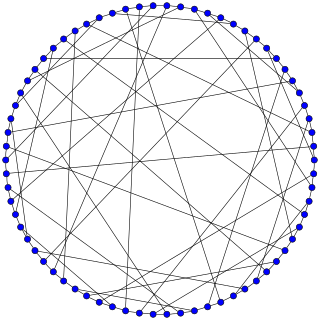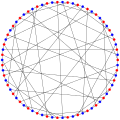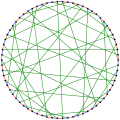Top Qs
Timeline
Chat
Perspective
Harries–Wong graph
From Wikipedia, the free encyclopedia
Remove ads
In the mathematical field of graph theory, the Harries–Wong graph is a 3-regular undirected graph with 70 vertices and 105 edges.[1]
The Harries–Wong graph has chromatic number 2, chromatic index 3, radius 6, diameter 6, girth 10 and is Hamiltonian. It is also a 3-vertex-connected and 3-edge-connected non-planar cubic graph. It has book thickness 3 and queue number 2.[2]
The characteristic polynomial of the Harries–Wong graph is
Remove ads
History
In 1972, A. T. Balaban published a (3-10)-cage graph, a cubic graph that has as few vertices as possible for girth 10.[3] It was the first (3-10)-cage discovered but it was not unique.[4]
The complete list of (3-10)-cages and the proof of minimality was given by O'Keefe and Wong in 1980.[5] There exist three distinct (3-10)-cage graphs—the Balaban 10-cage, the Harries graph and the Harries–Wong graph.[6] Moreover, the Harries–Wong graph and Harries graph are cospectral graphs.
Remove ads
Gallery
- The chromatic number of the Harries–Wong graph is 2.
- The chromatic index of the Harries–Wong graph is 3.
- Alternative drawing of the Harries–Wong graph.
- The 8 orbits of the Harries–Wong graph.
References
Wikiwand - on
Seamless Wikipedia browsing. On steroids.
Remove ads






